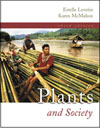
The Algae |  |
Chapter Summary1. The algae are a diverse group of photosynthetic organisms that occur in freshwater, oceans, and moist terrestrial environments, where they are the base of the food chain. They range from unicells to huge multicellular organisms. They differ from plants in many features. In particular, they lack extensive tissue differentiation and do not retain an embryo after sexual reproduction.
2. The cyanobacteria, also known as blue-green algae, are the only group of algae with prokaryotic cells. Some cyanobacteria are able to carry out nitrogen fixation. Diatoms and dinoflagellates are typically unicellular organisms. They serve a vital role in both marine and freshwater food chains as the food for other organisms. The greatest diversity of form is found among the green algae, which also play a major role in aquatic food chains. Red and brown algae, commonly called seaweeds, include large multicellular marine organisms, often with complex life cycles.
3. Various algae have been used as food by cultures around the world. Although some cyanobacteria have proved useful as food or food supplements, it is the red and brown seaweeds that provide products for both food and industrial applications. Some seaweeds are used directly as food; others are used as sources of alginic acid, carrageenan, and agar.
4. A negative aspect of the algae is related to environmental damage caused by algal blooms. Algal blooms are especially hazardous when the algae are capable of producing toxins. Dinoflagellates are probably the best known toxin producers, and blooms of these organisms are called Red Tides.
|
|
|